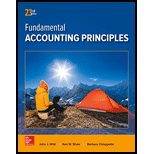
Concept Introduction:
1) Assets– It means what is owned by the business. The assets may be fixed assets or current assets. The current assets are those which can be easily converted into cash. All assets other than current assets are fixed assets. The fixed assets increase the earning capacity of the business.
2) Liability– It means what the business owes to the outside world. These are the claims against the assets of the company. The liabilities are of two types – long term liabilities and current liabilities. The current liabilities are those which are to be repaid within one year. The long term liabilities are those which are more than a year.
3) Equity– It means owner equity, which may be in form of share capital,
4) Net Assets – It means excess of total assets over liabilities.
Requirement -1- To define:
Assets, liabilities, Equity and net assets
Want to see the full answer?
Check out a sample textbook solution
Chapter 2 Solutions
Fundamental Accounting Principles
- NO AI ANSWERarrow_forwardMango Pest Control Ltd. has sales of $720,000, costs of $498,000, depreciation expense of $61,000, interest expense of $26,000, and a tax rate of 35 percent. What is the net income of the firm?arrow_forwardcan you help me with general accounting question with correct solution ?arrow_forward
- For Ikea Manufacturing, the predetermined overhead rate is 125% of direct labor cost. During the month, Ikea incurred $96,000 in total factory labor costs, of which $78,400 is direct labor and $17,600 is indirect labor. The actual manufacturing overhead incurred was $100,500. Compute the amount of manufacturing overhead applied during the month. Determine the amount of under- or overapplied manufacturing overhead.helparrow_forwardNot use ai solution please and general accountingarrow_forwardPlease give me correct answer this financial accounting questionarrow_forward

 AccountingAccountingISBN:9781337272094Author:WARREN, Carl S., Reeve, James M., Duchac, Jonathan E.Publisher:Cengage Learning,
AccountingAccountingISBN:9781337272094Author:WARREN, Carl S., Reeve, James M., Duchac, Jonathan E.Publisher:Cengage Learning, Accounting Information SystemsAccountingISBN:9781337619202Author:Hall, James A.Publisher:Cengage Learning,
Accounting Information SystemsAccountingISBN:9781337619202Author:Hall, James A.Publisher:Cengage Learning, Horngren's Cost Accounting: A Managerial Emphasis...AccountingISBN:9780134475585Author:Srikant M. Datar, Madhav V. RajanPublisher:PEARSON
Horngren's Cost Accounting: A Managerial Emphasis...AccountingISBN:9780134475585Author:Srikant M. Datar, Madhav V. RajanPublisher:PEARSON Intermediate AccountingAccountingISBN:9781259722660Author:J. David Spiceland, Mark W. Nelson, Wayne M ThomasPublisher:McGraw-Hill Education
Intermediate AccountingAccountingISBN:9781259722660Author:J. David Spiceland, Mark W. Nelson, Wayne M ThomasPublisher:McGraw-Hill Education Financial and Managerial AccountingAccountingISBN:9781259726705Author:John J Wild, Ken W. Shaw, Barbara Chiappetta Fundamental Accounting PrinciplesPublisher:McGraw-Hill Education
Financial and Managerial AccountingAccountingISBN:9781259726705Author:John J Wild, Ken W. Shaw, Barbara Chiappetta Fundamental Accounting PrinciplesPublisher:McGraw-Hill Education





